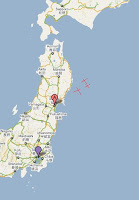New Blog I Like

Kitchen Garden Japan: Largely self-sufficient, Tom farms, Izumi cooks, Kento throws our organic fruit and vegetables at the wall. Haruto mainly gurgles and sleeps. Kitchen Garden Japan Quote: The quake just didn’t reach it this far. And nor, too, did the tsunami. The outlying island of Shikoku, home of Masanobu Fukuoka, an influence whose book “The One-Straw Revolution” partly inspires this project, blocked and diffused the wave. By the time it reached here, the wall of water was thankfully a mere 20cm high. And now you know why... Fukuoka’s message is most easily explained by his food mandala, pictured below, in which he advocates growing and eating seasonal foods. It’s not rocket science, just common sense, but it is sense that society’s “I want this and I want it now” culture overlooks all too easily. It’s all about harnessing seasons: Round and round So in the orchard, we’ve planted with eyes on succession; taranome, loquats, and cherries segue into apricots, plums and peaches, bef...







